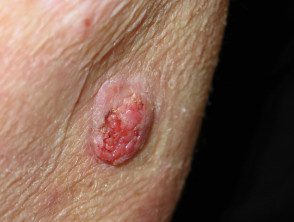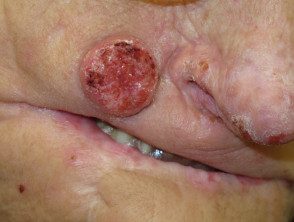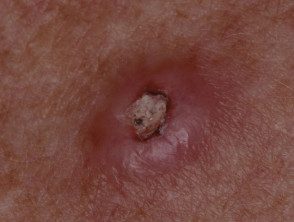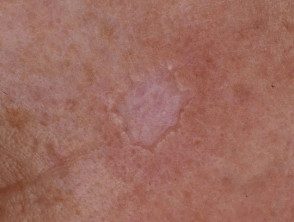Ad
Skin cancer
Application to facilitate skin self-examination and early detection. read more.
What are multiple self-heals? scaly epitheliomas?
Multiple self-healing squamous epitheliomas (MSSE) are a rare inherited skin condition characterized by the sudden onset of recurrent skin cancers that look good differentiated squamous cell carcinomas (SCC) or keratoacanthomas (KA) clinically and histologically. SCC/KA-like lesions tend to spontaneously regress, leaving pitted scars.
MSSE was first described in 1934 by the Scots Dermatologist J Ferguson-Smith, who reported a young man who had developed multiple self-healing squamous tumors. It was later reported in the patient's daughter, and in 1971, Malcolm A Ferguson-Smith (the dermatologist's son geneticist) presented information on 62 cases of MSSE from the west of Scotland, including pedigrees consistent with a autosomal dominant pattern of inheritance.
Other names for the disorder are:
- Family multiple keratoacanthomas
- Ferguson-Smith multiple keratoacanthomas
- Ferguson-Smith disease
What are the clinical features of MSSE?
In MSSE, SCC/KA-like lesions tend to first appear during the second or third decade of life. They arise in crops or individually, most commonly in sun-exposed areas and on sites of trauma. the injury starts off as a dull red taint which soon becomes a papule, and grows rapidly for 2–4 weeks. It can reach 2–3 cm in diameter, and remain stable for up to 2 months before involuting, leaving a boneless bone. scar.
Patients can have up to a hundred lesions over time.
Family members can develop these lesions despite having relatively little sun exposure in the past, unlike most people with SCC and KA.
SCC/KA-like lesions in mother and daughter with multiple familial keratoacanthomas

Ferguson-Smith disease SCC/KA

Ferguson-Smith disease SCC/KA

Ferguson-Smith disease SCC/KA

Ferguson-Smith disease SCC/KA
What are the genetics of MSSE?
Cases of MSSE have been identified in a wider geographical area, in Japan, America and Denmark, suggesting that the disease is more common than originally thought. In some families, the phenotype it is milder and the onset of the disease is later than in other families.
MSSE was initially thought to be caused by a founder mutation. Although the disease is inherited in a autosomal dominant fashion (from parents to half of their children), is not fully pervasive, as there are reports of obligation carriers showing no clinical symptoms Eleven different heterozygous mutations have been identified in the transformation Growth factor Beta Receiver 1 (TGFBR1) gene Located in Chromosome 9q22.
Wild-type TGFBR1 is thought to act as a tumor suppressor, up somatic Deletion of the wild-type gene by a second classic "hit" results in carcinogenesis.
How is MSSE diagnosed?
Familial multiple keratoacanthomas should be considered in patients presenting with SCC/KA-like lesions at a young age with a positive family history.
The characteristic histology of the familiar type differs from the usual KA, as there are no marked “shoulders”, and White blood cell Abscesses are absent. They appear to be aggressive SCC histologically, but are usually self-limiting.
the differential diagnosis of multiple familial keratoacanthomas include:
- SCC and non-familial KA
- KAs in Muir-Tower syndrome
- Generalized Eruptive KA of Grzybowski syndrome
- Xeroderma pigmentosum
DNA Blood or mouthwash samples may be obtained for linkage studies and haplotype analysis, looking for mutations in the TGFBR1 gene on chromosome 9q22. A heterozygous loss-of-function mutation in this gene leads to susceptibility to familial multiple keratoacanthomas.
In areas of high ultraviolet radiation (UV) exposure and high predominance of SCCs, the diagnosis of MSSE can be easily delayed or missed. Patients with early onset of histologically aggressive squamous cell carcinomas in young patients with a family history of other affected members should be investigated for possible MSSE.
What is the treatment for MSSE?
Although individual SCC/KA-like lesions will usually resolve spontaneously, treatment can hasten this and also improve the cosmetic result. Most lesions are surgically removed using excision or curettage and cauterization. Other reported treatments are:
- Cryotherapy
- intralesional bleomycin
- Intralesional 5-fluorouracil
While radiotherapy has been used for MSSE, this can lead to further development of new lesions within the treated field, so it is best avoided.
Oral retinoids such as acitretin and isotretinoin can be used to try to shrink the number of tumors.
MSSE patients should be advised to protect their skin from sun exposure.



